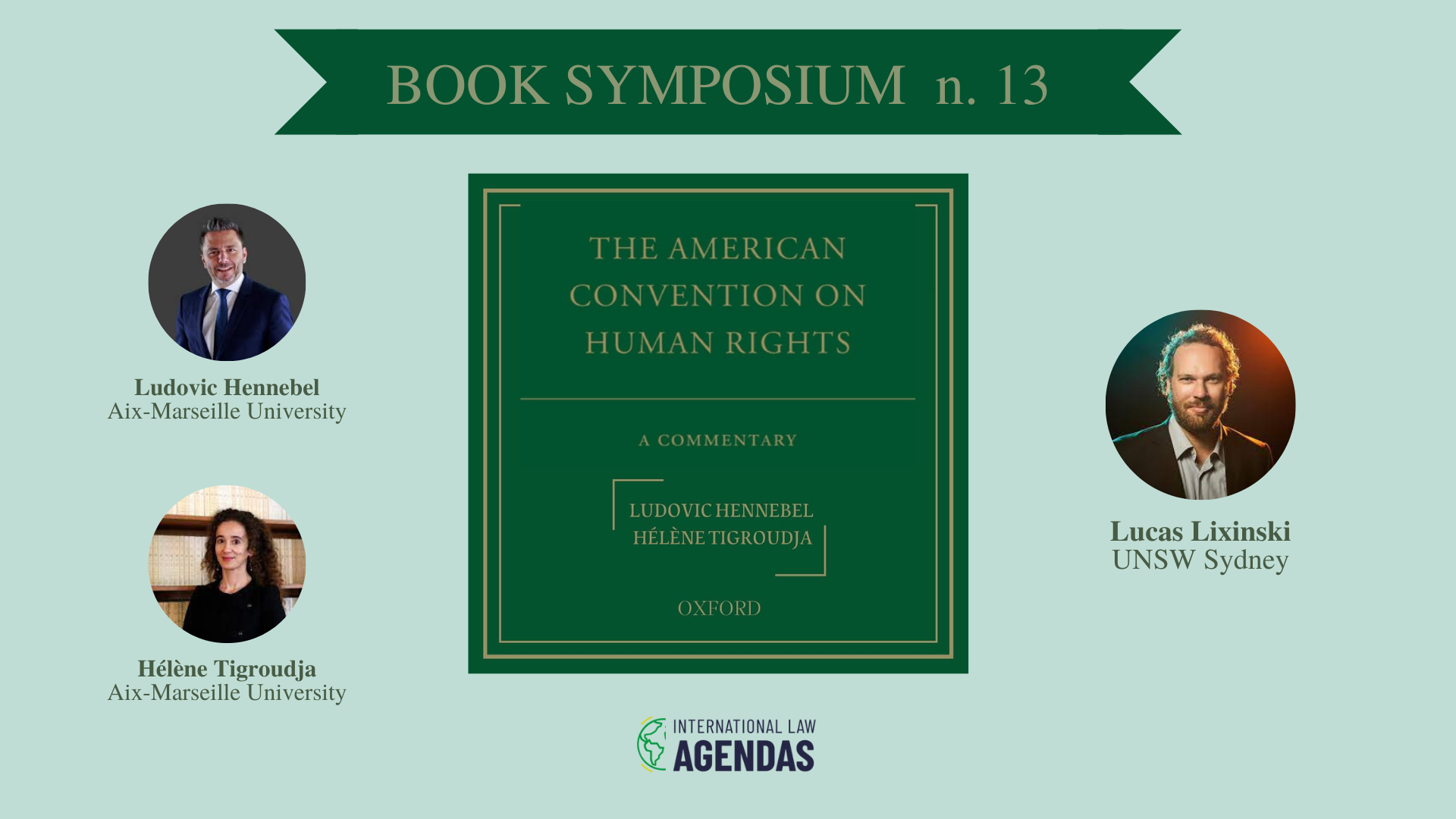Commentaries to international treaties are a specific genre of international legal literature. As reference resources, they must be comprehensive and up-to-date. Their structure is more often than not decided by the treaty itself and its idiosyncrasies at the time it was adopted, and not by the way the practice under the treaty has shaped the treaty. And they are hardly ever meant to be read from cover to cover. I had the pleasure of doing just the latter with Ludovic Hennebel and Hélène Tigroudja’s monumental The American Convention on Human Rights: A Commentary (OUP, 2022), and the review below suggests that, despite the significant importance and likely future impact of this book, more could have been done to enhance impact even further.
This commentary is the latest in a few other commentaries available in English published over the past few years (here and here). Unlike previous commentaries, however, Hennebel and Tigroudja take on the entire treaty, and not just selected substantive rights, therefore giving the reader important insights also on the institutional make-up of the system, and the importance of institutional frameworks for the pursuit of substantive developments in the law. These institutional insights, in my view, are particularly important for the Inter-American bodies (Commission and Court), given the originality of much of the jurisprudence of the system.
In other words, it pays to query whether it is the institutional make-up of the bodies that helps account for the progressiveness of the bodies, or if, instead, these bodies are progressive even without these contingencies. As the volume makes it clear, it is for the most part the latter, meaning that other international human rights institutions can afford to be progressive as well without dismissing or downplaying progressiveness on account of their own constitutional constraints.
The book adopts a similar structure for each of the articles, as it is customary in the commentary genre. The discussion of each article opens with an introduction that hints at the overall tone of the jurisprudence on the topic (for substantive rights) or general importance of the institutional feature (for the other provisions of the treaty). This introduction is followed by a discussion of the drafting history of the provision, which is very useful in a reference work, particularly for the institutional features, but not always likely to shed new light on the interpretation of substantive provisions (since human rights treaties are to be interpreted according to the circumstances of society as it evolves, rather than the circumstances in which they were adopted). The third part of the commentary to each article then reviews the relevant practice under the treaty, surveying primarily the jurisprudence of the Commission and Court, but also decisions and documents of Organization of American States bodies.
The effort to do an article-by-article analysis of the treaty and its practice is laudable, but at times comes across as a bit artificial to Inter-American system insiders, given the development of the jurisprudence to merge multiple rights in several areas of analysis. Two examples are: (1) enforced disappearances, which the Medina commentary linked above treats as a separate chapter; and (2) the right to access to justice, which the Antkowiak and Gonza commentary linked above treats – critically – in the combined fashion the Commission and Court do. Hennebel and Tigroudja recognize this possible limitation in their discussion of Article 17, for instance (p. 515), but it is worthwhile that they stick to the article-by-article model, as it is not only thorough, but also helps shed light on the reasons for the joint consideration of rights in certain contexts.
Another limitation of the article-by-article commentary genre for the American Convention is that certain doctrines which are not tied to specific articles are often not foregrounded. Examples are conventionality control, consensus interpretation, and pro persona interpretation. Hennebel and Tigroudja work valiantly to discuss all these doctrines in appropriate parts of their commentary, but them being subsumed under articles, as opposed to clearly foregrounded, left me with the impression that one needs to be a rather advanced user of the Inter-American system to fully benefit from these insights and this commentary.
Finally, and relatedly, there is the question of the readership for this commentary, and how to connect with it. The main working language of the Inter-American system is Spanish, given the states parties. So, a commentary in English would almost make more sense to an outsider readership, to enable people working with other regional or universal human rights systems to gain insight from the Inter-American experience. Hennebel and Tigroudja seem very aware of this potential, and often connect the Inter-American experience to the experience of other regional and universal human rights bodies in their analysis of substantive rights. And, in their analysis of institutional features, they often refer also to the International Court of Justice and the International Criminal Court. Doing so enables them to ground the American Convention, and the practice within it, in the general body of international (human rights) law to which the bodies of the system see themselves as belonging (as Hennebel and Tigroudja consistently point out).
This effort is valuable, but I wish more had been made of it. Specifically, a lot of the time the comparison is just descriptive and is simply “there”. Relatively few attempts are made to explain why or how differences matter, and their impact on the development of the law. For instance, at p. 894, a difference between the Inter-American and European systems’ basic institutional design is noted as “important”, but no explanation is given as to why the difference is important. Most of the references to the ICCPR and other main regional instruments are there simply for textual comparison. A refreshing and insightful exception is at p. 1202-1203 (on the Inter-American Court’s composition). I wish more of these discussions were contained in the book, even if it would further add to its size.
Relatedly, there is relatively little engagement with what the American Convention, and the practice under it, can teach other systems, at least not directly. Exceptions are in the areas of Indigenous rights (p. 644), reparations (p. 1307), and Inter-American Court provisional measures (p. 1335-1336).
Otherwise, there are more references to what the ACHR has learned from the ECHR, at least in the substantive rights part of the commentary. This mode of engagement, even if historically accurate (after all, the ACHR came into existence nearly 20 years after the ECHR, and the drafting of the former was influence by the latter’s language and early practice), sometimes comes across as unidirectional, and not always necessary. For instance, in the commentary to Article 8 ACHR, Hennebel and Tigroudja acknowledge that this is a particularly developed article in the system’s jurisprudence, to the point where they cannot take in all of this practice. But then they go on to couch their analysis on a series of references to how the European Court’s jurisprudence is the frame for analysis of Inter-American practice. Why not use the Inter-American system’s own categories?
Finally, despite the normally terrific engagement with the practice of the system and deep dive into drafting history, I would have enjoyed more direct and synthetic guidance not just on the current state of affairs of the practice under the ACHR, but also on how to implement and interpret each provision moving forward. In other words, the commentary does outstanding work on the past and present of the ACHR, but could have done more for the future, using the authority Hennebel and Tigroudja establish in the book to influence future directions of human rights theory and practice in the Americas and beyond.
Overall, Hennebel and Tigroudja’s commentary is an impressive and much-welcome addition to the literature and practice on international human rights law. It will surely be very useful as a reference work. Despite the authors not daring to do so directly themselves, their commentary is bound to shape future direction of practice within the system, or at least commentary thereto. I hope this commentary will be picked up broadly by the primarily Spanish- and -Portuguese speaking communities of practice of the ACHR, and that it will also work to add more connections to the ACHR in the work of other systems. I commend Hennebel and Tigroudja for this volume, and recommend it be read and used widely within and beyond the Americas.
Response by Ludovic Hennebel and Hélène Tigroudja
-

Professor Titular da Faculdade de Direito e Justiça da UNSW Sydney, e um dos editores desse blog.





